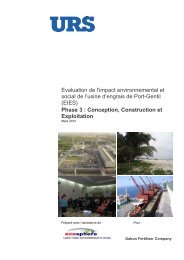En rapport avec le Réseau Interconnecté du Woleu-Ntem - Coface
En rapport avec le Réseau Interconnecté du Woleu-Ntem - Coface
En rapport avec le Réseau Interconnecté du Woleu-Ntem - Coface
Create successful ePaper yourself
Turn your PDF publications into a flip-book with our unique Google optimized e-Paper software.
Cette forêt secondaire sur pente est dominée par Erythroph<strong>le</strong>um ivorense. La<br />
présence de gros arbres de 40 m de hauteur restés sur pied, indique qu’il<br />
s’agissait d’une vieil<strong>le</strong> forêt secondaire qui a subit la pression humaine<br />
(cultures).<br />
Photo 2: Physionomie d'une vieil<strong>le</strong> forêt secondaire<br />
Transect 8 :<br />
Forêt très secondarisée sur une ancienne carrière dont <strong>le</strong>s espèces<br />
caractéristiques sont : Marcaranga barteri (Euphorbiaceae), Albizia<br />
adianthifolia (Mimosaceae), Mi<strong>le</strong>tia versicolor (Papilionaceae), Anthoc<strong>le</strong>ista<br />
vogelii (Loganiaceae).<br />
Dominance : Albizia adianthifolia et Anthoc<strong>le</strong>ista sp.<br />
La fin de ce transect est marquée, à 300 mètres environ de la route par un<br />
inselberg à pelouse (Afrotri<strong>le</strong>pis pilosa, Cyperaceae) et à Euphorbia <strong>le</strong>-testui<br />
(Euphorbiaceae).<br />
La végétation marécageuse :<br />
Le tab<strong>le</strong>au suivant donne <strong>le</strong>s caractéristiques des principaux marécages<br />
observés sur l’axe Oyem-Bitam.<br />
68<br />
EIES – <strong>Réseau</strong> interconnecté <strong>du</strong> Wo<strong>le</strong>u‐<strong>Ntem</strong><br />
Rapport final Novembre 2010






